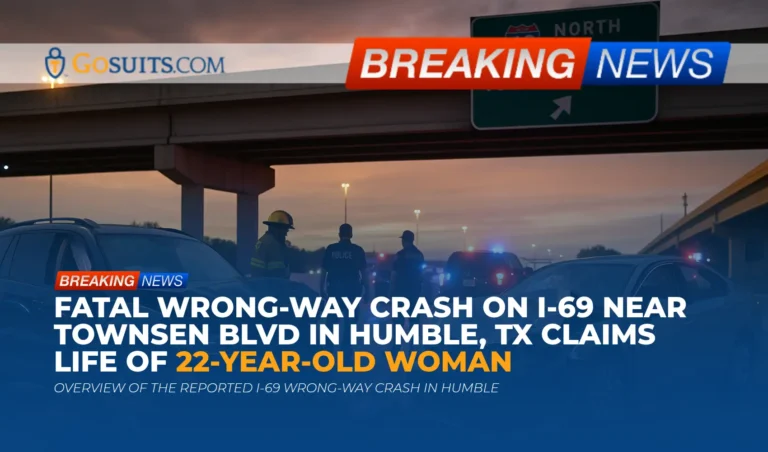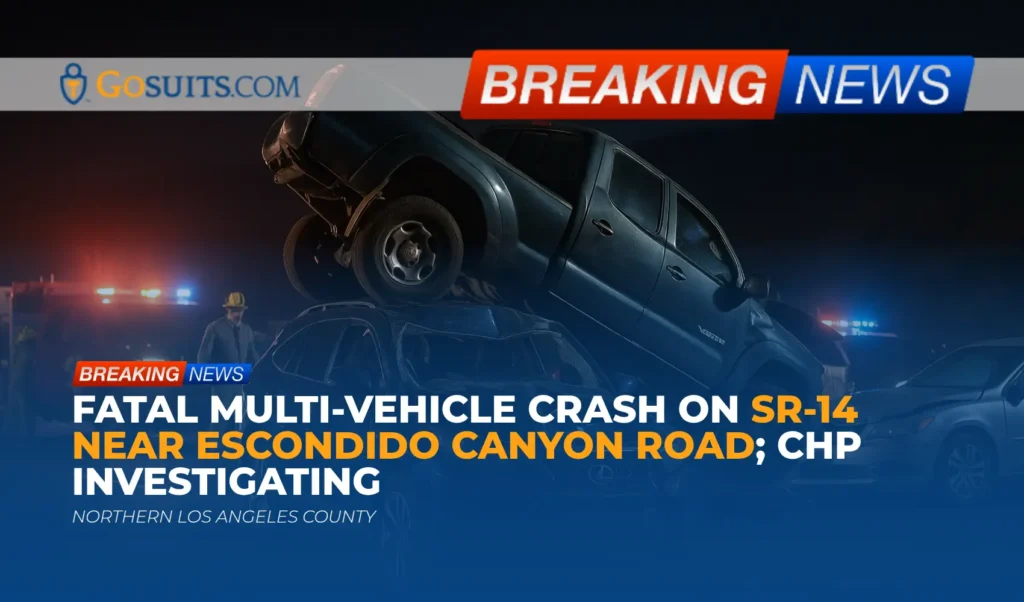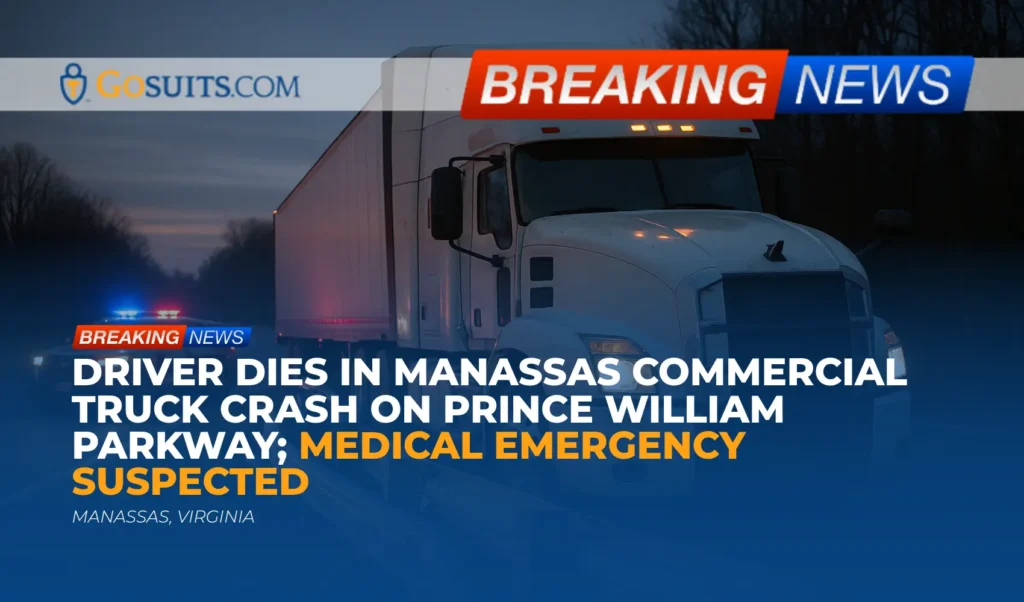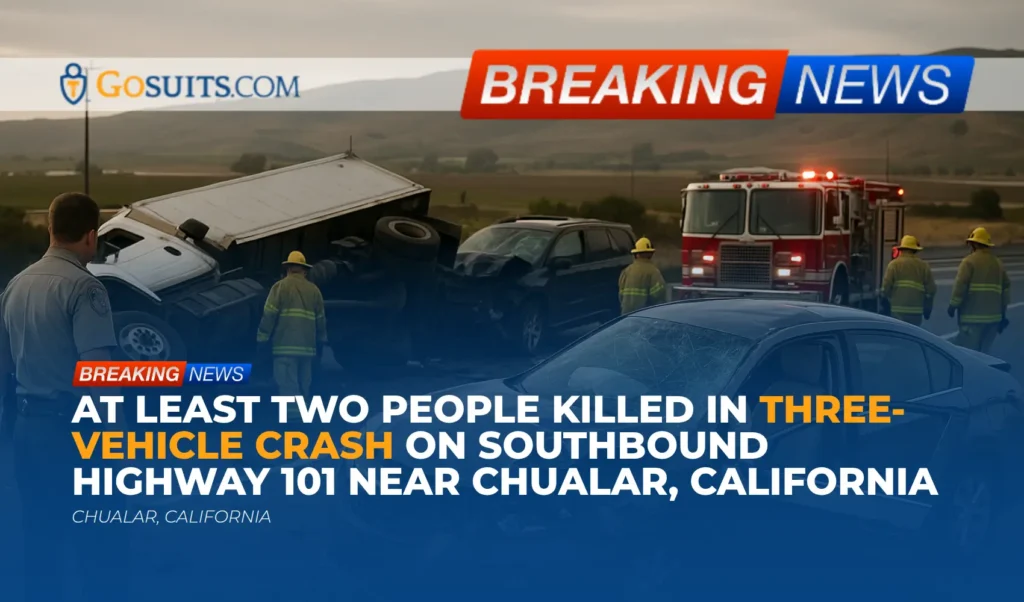- Overview of the reported I-69 wrong-way crash in Humble
- What is known and what remains unclear
- Safety context about wrong-way crashes on divided highways
- Immediate next steps families often take
- How to request official records and where to call
- Potential civil liability issues to consider
- Insurance considerations and common pitfalls
- Preserving evidence after a serious crash
- Helpful government resources
- Commentary from Gosuits Humble, Texas Personal Injury Attorney
- Action steps and timing considerations
Overview of the reported I-69 wrong-way crash in Humble
Authorities reported a fatal two-vehicle collision on the I-69 Eastex Freeway northbound near Townsen Boulevard in Humble, Texas. Preliminary information indicates that a 52-year-old man driving southbound in the northbound lanes struck another vehicle head-on. A 22-year-old woman was critically injured, received CPR at the scene, and was later pronounced deceased at a hospital. Northbound lanes were initially closed during the response and investigation, and later reopened the same evening. An investigation into the wrong-way travel is ongoing.
At this stage, officials have not publicly released the identities of those involved. This article summarizes what is publicly reported about the incident and explains common civil-law and safety issues that arise in wrong-way crashes on divided highways. It also highlights practical steps families typically take to obtain official records and protect their rights.
What is known and what remains unclear
What we know
– Location: I-69 Eastex Freeway northbound near Townsen Boulevard in Humble, Texas.
– Timeframe: Reported on a Saturday afternoon, with lanes reopening later that evening.
– Parties: A 22-year-old woman was fatally injured. A 52-year-old man reportedly traveled southbound in the northbound lanes.
– Sequence: Officials described a head-on, two-vehicle crash. First responders performed life-saving measures and transported the young woman, who was pronounced deceased at a hospital.
What remains unclear
– Identification: Names of the drivers and any passengers have not been publicly released.
– Contributing factors: The reason for the wrong-way travel has not been publicly stated. That might involve ongoing investigation into driver condition, lighting, roadway signage, navigational errors, or other factors.
– Additional injuries: It is not yet known whether the wrong-way driver or anyone else sustained additional injuries or required hospitalization.
– Citations or charges: Any criminal enforcement or citations have not been reported at this time, and are outside the scope of this civil-focused overview.
Safety context about wrong-way crashes on divided highways
Wrong-way crashes on high-speed, divided highways are uncommon relative to other crash types, yet they are disproportionately severe because they often involve head-on impacts at highway speeds. National safety agencies have studied this problem and identified typical contributing factors and proven countermeasures.
According to the National Transportation Safety Board, alcohol impairment is frequently associated with wrong-way driving on high-speed, controlled-access highways, and nighttime conditions are commonly involved. The NTSB’s special investigation into wrong-way driving discusses patterns seen nationwide and emphasizes the elevated risk of severe and fatal outcomes in these collisions. See the NTSB’s wrong-way driving report for background and safety recommendations at ntsb.gov.
The Federal Highway Administration provides engineering guidance to reduce wrong-way entries, including improved signing and pavement markings, lighting, strategically placed wrong-way signs with flashing beacons, wrong-way detection systems, and ramp design changes to make it harder to enter in the wrong direction. FHWA’s resource page on wrong-way countermeasures is available at safety.fhwa.dot.gov.
In Texas specifically, the Texas Department of Transportation also publishes information about wrong-way driving awareness and countermeasures used on state highways. For statewide safety information and campaigns, see TxDOT at txdot.gov.
Immediate next steps families often take
When a serious crash occurs, families are thrust into an unfamiliar process while grieving. The following steps outline how people often gather accurate information and maintain a clear record. These are general suggestions and not case-specific directives.
Confirm the reporting agency and obtain a case or incident number
On interstates and US highways in Texas, the investigating agency may be a city police department within city limits, a county agency, or the Texas Department of Public Safety. In this situation the response was reportedly within the City of Humble. Families typically contact the investigating agency’s records unit to confirm the incident number, which will be needed for crash-report requests and other records. If it is unclear which agency has primary jurisdiction, a call to the city police department’s records division can help direct the request.
Request the official Texas crash report
Texas crash reports are maintained in the Texas Department of Transportation CRIS system. Eligible parties can search and purchase a copy once the report is finalized by the investigating officer. TxDOT provides the process and portal here: cris.dot.state.tx.us.
Autopsy and toxicology information
Harris County deaths that fall under medical examiner jurisdiction are handled by the Harris County Institute of Forensic Sciences. Next of kin can request decedent records, including autopsy and, when completed, toxicology findings. The agency explains how to request records at ifs.harriscountytx.gov. Processing times can vary as comprehensive testing is completed.
Death certificates
Certified death certificates in Texas are issued through the Texas Department of State Health Services Vital Statistics Section. Information on eligibility, ordering, and local registrar offices is provided by DSHS at dshs.texas.gov.
Victim assistance and financial support resources
Texas operates a Crime Victims’ Compensation Program that may help with certain out-of-pocket costs for victims of violent crimes. Eligibility depends on the circumstances of the incident. Information and application steps are available through the Office of the Attorney General at texasattorneygeneral.gov.
Traffic management updates
For future roadway incidents, statewide travel and lane closure information is provided by TxDOT. General traveler and safety information is available through TxDOT at txdot.gov.
How to request official records and where to call
Police crash report
– What it is: The Texas Peace Officer’s Crash Report documents the location, vehicles, drivers, roadway conditions, witness statements, and officer observations. It is foundational for civil claims.
– Where to get it: TxDOT’s CRIS portal at cris.dot.state.tx.us. If the report is not yet available, the investigating agency’s records unit can provide estimated completion timing using the case number.
Autopsy and medical examiner records
– What they are: When a fatality is investigated by the medical examiner, records may include an autopsy report, medical examiner investigator notes, and toxicology results when complete. These records often clarify causes and mechanisms of injury, and may address contributory factors such as intoxication.
– Where to get them: Harris County Institute of Forensic Sciences offers instructions for next of kin to request decedent records at ifs.harriscountytx.gov.
Hospital and EMS records
– What they are: EMS run sheets and hospital emergency department records can document life-saving measures, timing, and medical findings.
– How to request: Next of kin or authorized representatives can request these records from the EMS provider and hospital health information management departments under HIPAA provisions. Hospitals and EMS providers will specify authorization requirements.
Death certificate
– What it is: The official record of death, required for many estate, insurance, and benefits processes.
– Where to get it: Texas DSHS Vital Statistics at dshs.texas.gov.
Public information requests for 911 audio or traffic-camera metadata
– What they are: Depending on the agency’s retention policies, dispatch logs, 911 call audio, and certain video or metadata may be requested by the public. Availability and exemptions vary.
– How to request: Texas Public Information Act requests are governed by the Office of the Attorney General. Guidance for members of the public on making a request is available at texasattorneygeneral.gov.

Potential civil liability issues to consider
Every case turns on specific facts, evidence, and law. The following outlines common civil-law questions in wrong-way highway collisions, framed generally.
Driver negligence for wrong-way travel
Texas law requires drivers to operate on the right half of a roadway except under limited circumstances. See Texas Transportation Code section 545.051 at statutes.capitol.texas.gov. Entering and traveling in the wrong direction on a controlled-access highway is commonly analyzed as a breach of the duty to drive with reasonable care. If a wrong-way driver’s breach causes a collision and injuries, that driver’s auto liability insurance generally becomes a primary source of compensation.
Comparative responsibility
Texas applies proportionate responsibility in civil cases. A claimant’s damages can be reduced by any percentage of responsibility assigned to them, and recovery is barred if that responsibility is greater than 50 percent. See Texas Civil Practice and Remedies Code section 33.001 at statutes.capitol.texas.gov. In a wrong-way head-on crash, the allocation of responsibility often focuses on the wrong-way entry, visibility, signage, roadway design, lighting, and driver behavior.
Alcohol service liability
If evidence shows a driver was obviously intoxicated and was served alcohol at a licensed establishment, Texas law may allow a civil dram shop claim against the provider under the Texas Alcoholic Beverage Code, Chapter 2. See statutes.capitol.texas.gov. Such claims require careful factual development and are highly case specific.
Roadway signage and governmental responsibility
Questions sometimes arise regarding the adequacy of signage, lighting, or ramp design intended to deter wrong-way entries. Claims involving government entities are subject to strict notice requirements and limited waivers of sovereign immunity under the Texas Tort Claims Act. See Texas Civil Practice and Remedies Code Chapter 101 at statutes.capitol.texas.gov. These claims are complex and depend on detailed engineering and legal analysis.
Statute of limitations
In Texas, a civil action for personal injury or wrongful death is generally required to be filed within two years. See Texas Civil Practice and Remedies Code section 16.003 at statutes.capitol.texas.gov. There are exceptions that can shorten or extend time in specific circumstances, so it is important to confirm the applicable deadline for any claim.
Insurance considerations and common pitfalls
Catastrophic crashes implicate multiple layers of insurance. The following are general considerations frequently encountered after a wrong-way collision.
Liability coverage of the at-fault driver
Texas requires a minimum level of liability insurance for drivers operating a vehicle. The Texas Department of Insurance explains required minimums and basic coverages at tdi.texas.gov. In serious or fatal crashes, minimum limits may be insufficient to address the harms and losses. Additional personal assets or umbrella policies may be relevant depending on the driver’s coverage.
Uninsured and underinsured motorist coverage
When the at-fault driver lacks insurance or carries inadequate limits, a victim’s own policy may include uninsured motorist or underinsured motorist coverage. These coverages are optional in Texas but must be offered. Claims against one’s own insurer can still be adversarial. Before speaking with any insurer about the facts of the crash, it is prudent to consult with a seasoned attorney to understand rights and risks. Statements made to insurance adjusters can be recorded and may be used later in ways that affect the claim.
Personal Injury Protection and medical payments
Some policies include Personal Injury Protection or medical payments coverage that can help with immediate out-of-pocket medical expenses or certain benefits, depending on the policy. The availability and coordination of these benefits depend on the exact policy terms.
Recorded statements and releases
Insurers often request recorded statements, medical authorizations, and early settlement releases. Providing broad authorizations or statements without understanding the implications can affect claim value or liability assessments. It is generally advisable to speak with an attorney before engaging in these steps.
Preserving evidence after a serious crash
Meaningful civil investigations rely on fast, careful evidence preservation. The following items often prove important in wrong-way collisions.
Vehicle preservation and event data recorders
Modern vehicles frequently contain event data recorders that capture speed, throttle, braking, and seatbelt status at or near the time of a crash. Promptly placing the involved vehicles on legal hold prevents spoliation. The National Highway Traffic Safety Administration provides a general fact sheet about event data recorders at nhtsa.gov.
Scene documentation
Photographs, measurements of skid or yaw marks, debris fields, and roadway signage at the entry point are often critical. On controlled-access highways, wrong-way entries often occur at ramps, crossovers, or access points, so documenting those locations promptly can matter.
Public information and traffic systems
Some agencies operate traffic cameras or wrong-way detection systems. Availability of video varies, and retention periods may be very short. Submitting a timely public information request can help determine what data exist. The Texas Attorney General provides guidance for public information requests at texasattorneygeneral.gov.

Medical and EMS records
Emergency medical records establish timing, interventions, and injury mechanics. Prompt requests to EMS and hospital health information departments help ensure these records are preserved.
Helpful government resources
- TxDOT Crash Report Portal: cris.dot.state.tx.us
- Harris County Institute of Forensic Sciences: ifs.harriscountytx.gov
- Texas Death Certificates: dshs.texas.gov
- Texas Public Information Act Requests: texasattorneygeneral.gov
- NTSB Wrong-Way Driving Report: ntsb.gov
- FHWA Wrong-Way Countermeasures: safety.fhwa.dot.gov
- Texas Auto Insurance Basics: tdi.texas.gov
- Texas Civil Practice and Remedies Code section 16.003 (limitations): statutes.capitol.texas.gov
- Texas Transportation Code section 545.051: statutes.capitol.texas.gov
- Texas Proportionate Responsibility: statutes.capitol.texas.gov
- Texas Dram Shop Statute: statutes.capitol.texas.gov
- Texas Tort Claims Act: statutes.capitol.texas.gov
Commentary from Gosuits Humble, Texas Personal Injury Attorney
Our hearts go out to everyone affected by this devastating loss near Townsen Boulevard. This discussion is offered for educational and general informational purposes, especially for those in the community seeking to understand what happens after a wrong-way highway crash.
From a civil-injury perspective, a head-on collision caused by reported wrong-way travel on a controlled-access freeway raises immediate questions about how and where the wrong-way entry occurred, the condition of the driver, signage and lighting at the last opportunity to avoid entering wrongly, and whether any vehicle or roadway factors played a role. Early, careful documentation is essential. The official crash report, scene photographs, medical examiner findings, and any available traffic system data inform those answers.
Insurance carriers and large corporate defendants often move quickly to manage their exposure. They may seek recorded statements, broad medical authorizations, or early settlement discussions before a full picture is developed. People new to this process can feel pressure to talk or sign without understanding how those decisions may affect them later. Insurers use policy language, claim procedures, and recorded statements to shape liability and damages assessments. Taking time to understand rights and obligations first can make a significant difference.
A free consultation with a seasoned injury attorney is important because it allows families to ask questions without obligation, understand the legal timelines, and learn about evidence preservation before any communication with insurers. It also provides context for evaluating policy limits, potential additional coverage, and whether other responsible parties might be implicated depending on the facts. No two cases are alike, and early guidance can help avoid missteps that are difficult to undo.
Action steps and timing considerations
The aftermath of a fatal crash is overwhelming. The following points explain what should be done, why it matters, and why timing is important.
- Identify the investigating agency and secure the incident number. Knowing the case number ensures later records requests and insurance notifications are accurate. It prevents delays and confusion when ordering the official crash report.
- Request the official crash report through TxDOT CRIS as soon as it is available. The crash report anchors the civil investigation. It often lists contributing factors, diagrams, witness contacts, and vehicle information. Waiting too long can slow insurance evaluations and evidence collection.
- Ask the medical examiner’s office about the status of autopsy and toxicology. These records may clarify cause of death and possible impairment or medical events. Toxicology can take time, so placing the request early helps ensure timely updates when results are ready.
- Preserve vehicles and critical evidence immediately. Vehicles can be moved, repaired, or destroyed by storage facilities without notice. A written preservation request helps protect event data, physical damage patterns, and restraint evidence that can be crucial later.
- Collect scene and signage photos while conditions are similar. Roadside evidence fades quickly and signage may change. Capturing ramp entrances, wrong-way signs, lighting, and line-of-sight conditions helps experts evaluate how the wrong-way entry occurred.
- Do not provide recorded statements to any insurer before obtaining legal guidance. Statements can be used to limit recovery or shift fault. Consulting an attorney first helps ensure communications are accurate, complete, and strategic.
- Review all available insurance coverages early. Understanding liability limits, uninsured or underinsured motorist coverage, and any medical or personal injury protection helps plan for expenses and set expectations. Early review prevents missed notice deadlines and preserves rights.
- Track all expenses and impacts from day one. Maintain a file for funeral expenses, medical bills, travel, lost income, and other out-of-pocket costs. Detailed documentation supports later claims and reduces disputes about the scope of loss.
- Calendar legal deadlines. Texas generally applies a two-year limitations period for personal injury and wrongful death claims. Some claims have shorter notice requirements, especially if a governmental entity might be involved. Tracking these dates prevents inadvertent forfeiture of rights.
- Seek supportive services promptly. Grief resources, victim assistance programs, and community services can help with immediate needs. Early outreach can reduce financial and administrative stress during a difficult time.
These steps emphasize urgency because evidence degrades, memories fade, and legal timelines continue to run even while families are grieving. Acting methodically, with informed guidance, helps protect both the search for answers and the ability to hold the correct parties civilly responsible when the investigation supports it.






